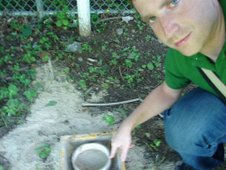

By Matthew Lysiak
The Brooklyn Paper
Another voice has jumped into the debate over the so-called “Green Church” — this one from the grave.
When the Bay Ridge United Methodist Church building was built almost 100 years ago, it was consecrated with a ceremony for the dead who were reinterred from the original church — the very same dead who will now be dug up when the Green Church is torn down for condos.
It’s almost certainly not how those former congregants would have wanted to be treated, says local historian David Elligers.
He recently unearthed a news article from 1901 that made it clear that those early Methodist congregants felt that the church ground was sacred.
“The present generation did not desire the bones of their ancestors scattered to the four winds of heaven,” the article reported.
The relocation of the congregants’ remains became necessary in 1900, when the city purchased the site of Grace’s Methodist Church — including its cemetery — in order to expand roads around what is now Sixth Avenue and 67th Street.
At that time, community members were invited to watch as workers sifted the dirt “to make sure that not a single bone was left behind,” said the church’s then-Pastor W.L. Davidson.
The bones were dug up and moved to their current resting place in front of the Green Church at the corner of Fourth and Ovington avenues in 1901 (see photo).
“It is clear that this was very important to the community of that day,” said Elligers. “It looks like they really wanted to ensure a proper resting place for these people.”
The engraving says that “211 bodies were transferred July, 1901 from the old cemetery of the First Methodist Episcopal Church of the town of New Utrecht at Cowenhoven Lane and Sixth Avenue. Ninety of the persons were unidentified. The names of the others were on church records.”
The newspaper article also reported that some remains were of communal and historical importance, including church elder Adrian Bogart. “His body was held in high regards by all Methodists,” the article said.
Today’s congregation does not feel the same obligation to allow the community to observe the re-interment — and it isn’t afraid to say it.
“It is none of your business, or anyone else’s” said Pastor Robert Emerick. “We are a competent religious organization and we know how to handle human remains.”
Community members looking for information on the current fate of the remains have run into a stone wall sturdier than the Pennsylvania limestone that gives Bay Ridge United Methodist its green hue. But this contentious relationship wasn’t created in six nights and seven days.
The trouble began shortly after reports of the sale of the Methodist cathedral, when Councilman Vince Gentile (D–Bay Ridge) hosted a community meeting in hopes of opening up a dialogue with the sale-minded congregants. But the congregants fought back, claiming that the councilman was trying to infringe on the separation of church and state.
Emerick was later quoted as referring to the remains as “only dust,” much to the chagrin of community activists hoping to preserve a piece of Bay Ridge past. Afterwards the pastor decided it would be best to tune-out the media entirely.
“I have decided that I am not going to dignify this process with a response any longer,” Emerick said. “I am not happy with how the media has handled this, so I am not going to answer any more questions.”

No comments:
Post a Comment